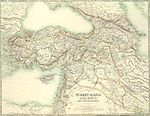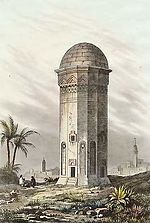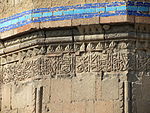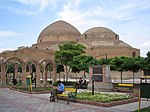Qara Qoyunlu: Difference between revisions
Undo |
Relurgotov (talk | contribs) No edit summary Tags: Reverted Visual edit Mobile edit Mobile web edit |
||
| (One intermediate revision by the same user not shown) | |||
| Line 23: | Line 23: | ||
| image_map_caption = Kara Koyunlu of the Turkomans, lighter blue shows their greatest extent in Iraq and Arabian East Coast for a small period of time |
| image_map_caption = Kara Koyunlu of the Turkomans, lighter blue shows their greatest extent in Iraq and Arabian East Coast for a small period of time |
||
| capital = [[Tabriz]] |
| capital = [[Tabriz]] |
||
| common_languages = {{ |
| common_languages = *[[Azerbaijani language|Azerbaijani]] <small>(poetry)</small>{{sfn|Minorsky|1954|p=283}} |
||
*[[Azerbaijani language|Azerbaijani]] <small>(poetry)</small>{{sfn|Minorsky|1954|p=283}} |
|||
*[[Persian language|Persian]] <small>(poetry)</small>{{sfn|Minorsky|1954|p=283}}}} |
|||
| religion = [[Shia]] [[Islam]] |
| religion = [[Shia]] [[Islam]] |
||
| currency = |
| currency = |
||
| Line 34: | Line 32: | ||
| title_leader = [[List of rulers of Kara Koyunlu|Ruler]] |
| title_leader = [[List of rulers of Kara Koyunlu|Ruler]] |
||
| p2 = Sutayids |
| p2 = Sutayids |
||
|demonym=|area_km2=|area_rank=|GDP_PPP=|GDP_PPP_year=|HDI=|HDI_year=|today=}} |
|||
}} |
|||
{{History of Azerbaijan}} |
{{History of Azerbaijan}} |
||
{{Anatolian History timeline infobox}} |
{{Anatolian History timeline infobox}} |
||
{{History of Iran}} |
{{History of Iran}} |
||
The '''Kara Koyunlu''' or '''Qara Qoyunlu''', also called the '''Black Sheep Turkomans''' ({{lang-fa|قره قویونلو}}), were a [[Islam|Muslim]] [[Turkoman (ethnonym)|Turkoman]]<ref>{{cite book |last1=Philippe |first1=Beaujard |title=The Worlds of the Indian Ocean |date=2019 |publisher=Cambridge University Press |location=Chapter 17 - Western Asia: Revival of the Persian Gulf |isbn=9781108341219 |pages=515–521}} "In a state of demographic stagnation or downturn, the region was an easy prey for nomadic '''Turkmen'''. The '''Turkmen''', however, never managed to build strong states, owing to a lack of sedentary populations (Martinez-Gros 2009: 643). When Tamerlane died in 1405, the Jalāyerid sultan Ahmad, who had fled Iraq, came back to Baghdad. Five years later, he died in Tabriz (1410) in a battle led against the '''Turkmen Kara Koyunlu''' (“[Those of the] Black Sheep”), who took Baghdad in 1412." </ref><ref>{{cite web |title=Kara Koyunlu |url=https://www.britannica.com/topic/Kara-Koyunlu |website=Encyclopaedia Britannica}} "Kara Koyunlu, also spelled Qara Qoyunlu, Turkish Karakoyunlular, English Black Sheep, '''Turkmen''' tribal federation that ruled Azerbaijan, Armenia, and Iraq from about 1375 to 1468."</ref><ref>{{cite book |title=The Book of Dede Korkut |url=https://archive.org/details/bookofdedekorkut0000unse |url-access=registration |date=1972 |publisher=University of Texas Press |isbn=0-292-70787-8 |page=Introduction |edition=F.Sumer, A.Uysal, W.Walker}} "Better known as '''Turkomans'''... the interim Ak-Koyunlu and Karakoyunlu dynasties..."</ref> monarchy that ruled over the territory comprising present-day [[Azerbaijan]], [[Georgia (country)|Georgia]], [[Armenia]], |
The '''Kara Koyunlu''' or '''Qara Qoyunlu''', also called the '''Black Sheep Turkomans(<nowiki>[[Azerbaijani]]</nowiki>:Qara Qoyunlu)''' ({{lang-fa|قره قویونلو}}), were a [[Islam|Muslim]] [[Turkoman (ethnonym)|Turkoman]]<ref>{{cite book |last1=Philippe |first1=Beaujard |title=The Worlds of the Indian Ocean |date=2019 |publisher=Cambridge University Press |location=Chapter 17 - Western Asia: Revival of the Persian Gulf |isbn=9781108341219 |pages=515–521}} "In a state of demographic stagnation or downturn, the region was an easy prey for nomadic '''Turkmen'''. The '''Turkmen''', however, never managed to build strong states, owing to a lack of sedentary populations (Martinez-Gros 2009: 643). When Tamerlane died in 1405, the Jalāyerid sultan Ahmad, who had fled Iraq, came back to Baghdad. Five years later, he died in Tabriz (1410) in a battle led against the '''Turkmen Kara Koyunlu''' (“[Those of the] Black Sheep”), who took Baghdad in 1412." </ref><ref>{{cite web |title=Kara Koyunlu |url=https://www.britannica.com/topic/Kara-Koyunlu |website=Encyclopaedia Britannica}} "Kara Koyunlu, also spelled Qara Qoyunlu, Turkish Karakoyunlular, English Black Sheep, '''Turkmen''' tribal federation that ruled Azerbaijan, Armenia, and Iraq from about 1375 to 1468."</ref><ref>{{cite book |title=The Book of Dede Korkut |url=https://archive.org/details/bookofdedekorkut0000unse |url-access=registration |date=1972 |publisher=University of Texas Press |isbn=0-292-70787-8 |page=Introduction |edition=F.Sumer, A.Uysal, W.Walker}} "Better known as '''Turkomans'''... the interim Ak-Koyunlu and Karakoyunlu dynasties..."</ref> monarchy that ruled over the territory comprising present-day [[Azerbaijan]], [[Georgia (country)|Georgia]], [[Armenia]], |
||
northwestern [[Iran]], eastern [[Turkey]], and northeastern [[Iraq]] from about 1374 to 1468.{{sfn|Hovanissian|2004|p=4}}<ref>[http://www.britannica.com/eb/article-9044666/Kara-Koyunlu Encyclopædia Britannica. "Kara Koyunlu". Online Edition, 2007]</ref> |
northwestern [[Iran]], eastern [[Turkey]], and northeastern [[Iraq]] from about 1374 to 1468.{{sfn|Hovanissian|2004|p=4}}<ref>[http://www.britannica.com/eb/article-9044666/Kara-Koyunlu Encyclopædia Britannica. "Kara Koyunlu". Online Edition, 2007]</ref> |
||
Revision as of 11:11, 22 November 2020
Kara Koyunlular Black Sheep Turkomans قره قویونلو | |||||||||||
|---|---|---|---|---|---|---|---|---|---|---|---|
| 1374–1468 | |||||||||||
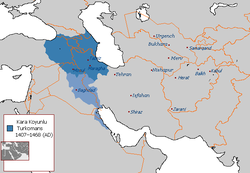 Kara Koyunlu of the Turkomans, lighter blue shows their greatest extent in Iraq and Arabian East Coast for a small period of time | |||||||||||
| Status | Confederation | ||||||||||
| Capital | Tabriz | ||||||||||
| Common languages |
| ||||||||||
| Religion | Ruler | | |||||||||
• 1375–1378 | Bayram Khwaja | ||||||||||
• 1467–1468 | Hasan 'Ali | ||||||||||
| Historical era | Middle Ages | ||||||||||
• Established | 1374 | ||||||||||
• Disestablished | 1468 | ||||||||||
| |||||||||||
| History of Azerbaijan | |
|---|---|
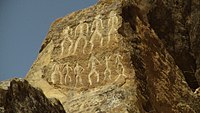 | |
| c.700 BC–c.590s BC | |
| Achaemenid Empire | 550 BC–330 BC |
| • Satrapy of Media | c.550 BC – 323 BC |
| Seleucid Empire | 312 BC – 63 BC |
| Parthian Empire | 247 BC – AD 224 |
| Caucasian Albania | c.200 BC – c.AD 800 |
| Roman Empire | 27 BC – AD 395 |

